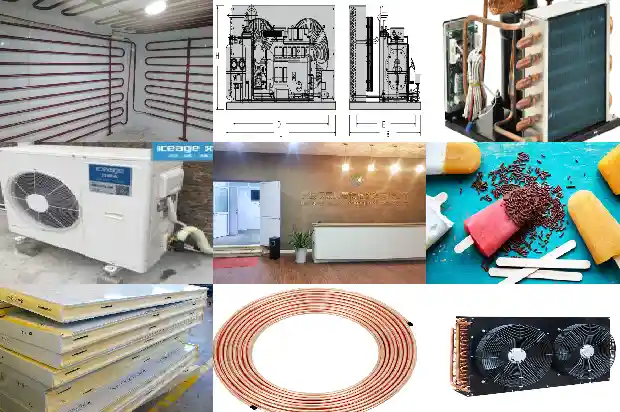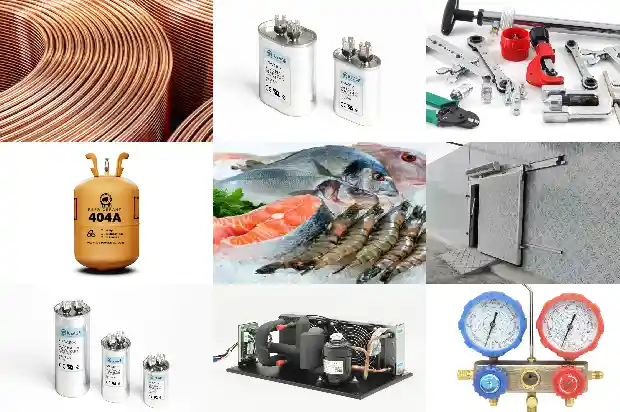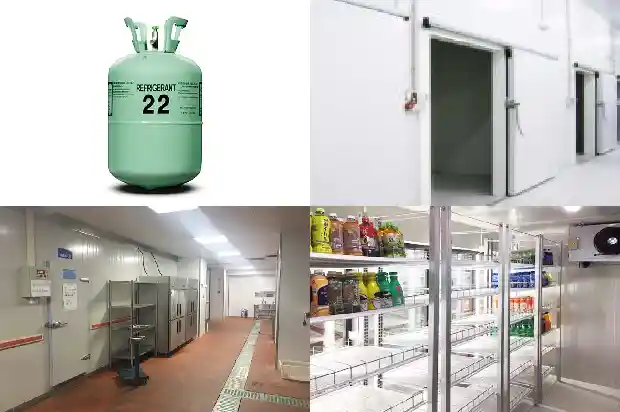Common Four Faults and Replacement Methods of Scroll Compressor
2024-09-23
First step: Electrical detection of compressor
Voltage and current measurement: At the output end of the compressor's AC contactor, used to determine whether the power supply voltage and starting voltage of the compressor are within the normal range.
Insulation resistance: The resistance from the compressor terminal to the ground. Generally, a megohmmeter or the ohmmeter range (40 megohm range) of a multimeter can be used to test between the compressor terminal and the copper tube on the compressor. Generally, it is more than 40 megohms. If there is liquid refrigerant in the compressor or the air humidity is high, the insulation resistance value will be relatively small.
Voltage and current measurement: At the output end of the compressor's AC contactor, used to determine whether the power supply voltage and starting voltage of the compressor are within the normal range.
Insulation resistance: The resistance from the compressor terminal to the ground. Generally, a megohmmeter or the ohmmeter range (40 megohm range) of a multimeter can be used to test between the compressor terminal and the copper tube on the compressor. Generally, it is more than 40 megohms. If there is liquid refrigerant in the compressor or the air humidity is high, the insulation resistance value will be relatively small.
Second step: Replace the faulty compressor
When welding down system components, the refrigerant should be discharged first. Refrigerant discharge should be carried out from both the high-pressure side and the low-pressure side. If only discharged from the high-pressure side, the scroll seal will cause the refrigerant to still remain on the low-pressure side. When welding off the connecting pipe, a mixture of refrigerant and oil will spurt out and be ignited when encountering a flame.
If the compressor needs to be replaced, the connecting pipes on both sides of the compressor must be cut off first before taking out the compressor.
If the compressor is damaged due to motor burnout, the degree of contamination of the lubricating oil should be checked. Before replacing the compressor, the gas-liquid separator and the drying filter should be replaced at the same time, and a drying filter should be added on the suction side. After the system runs for a period of time, check the degree of contamination of the filter element to determine whether a filter is still needed to continue cleaning the system.
When welding down system components, the refrigerant should be discharged first. Refrigerant discharge should be carried out from both the high-pressure side and the low-pressure side. If only discharged from the high-pressure side, the scroll seal will cause the refrigerant to still remain on the low-pressure side. When welding off the connecting pipe, a mixture of refrigerant and oil will spurt out and be ignited when encountering a flame.
If the compressor needs to be replaced, the connecting pipes on both sides of the compressor must be cut off first before taking out the compressor.
If the compressor is damaged due to motor burnout, the degree of contamination of the lubricating oil should be checked. Before replacing the compressor, the gas-liquid separator and the drying filter should be replaced at the same time, and a drying filter should be added on the suction side. After the system runs for a period of time, check the degree of contamination of the filter element to determine whether a filter is still needed to continue cleaning the system.
Third step: Storage and handling of new compressor
During the handling of a new compressor, the compressor should be kept vertical.
During the handling of a new compressor, the compressor should be kept vertical.

Fourth step: Remove the sealing plug and fix the bottom feet
When the compressor leaves the factory, it is filled with a certain pressure of dry air and then sealed with a rubber sealing plug. The purpose is to ensure cleanliness and dryness. Since the suction pipe opening is close to the oil level, before installation, the exhaust plug should be pulled out first, and then the suction plug. Use a cloth to clean the inner ring of the suction pipe opening and wipe off the oil film layer for easy welding.
Put the steel sleeve into the fixing bolt respectively, then lift the compressor into the installation position, and then gently tighten the nut with washer. When tightening the nut with washer, if too much force is applied, the sleeve may tilt or even break, which will cause vibration and noise.
When the compressor leaves the factory, it is filled with a certain pressure of dry air and then sealed with a rubber sealing plug. The purpose is to ensure cleanliness and dryness. Since the suction pipe opening is close to the oil level, before installation, the exhaust plug should be pulled out first, and then the suction plug. Use a cloth to clean the inner ring of the suction pipe opening and wipe off the oil film layer for easy welding.
Put the steel sleeve into the fixing bolt respectively, then lift the compressor into the installation position, and then gently tighten the nut with washer. When tightening the nut with washer, if too much force is applied, the sleeve may tilt or even break, which will cause vibration and noise.

Fifth step: Welding of compressor suction and exhaust pipes
Attention! Many compressor suction and exhaust pipes are copper-plated steel pipes. It is best to use solder with at least 5% silver. If solder with less than 2% silver is used, very good skills must be guaranteed. Pay attention that the solder should not enter the compressor and cause failure.
During welding, a small amount of nitrogen should be introduced to prevent the generation of oxides and falling into the compressor and causing failure. Do not overheat the pipe orifice. The welding time is 15-20 seconds.
Attention! Many compressor suction and exhaust pipes are copper-plated steel pipes. It is best to use solder with at least 5% silver. If solder with less than 2% silver is used, very good skills must be guaranteed. Pay attention that the solder should not enter the compressor and cause failure.
During welding, a small amount of nitrogen should be introduced to prevent the generation of oxides and falling into the compressor and causing failure. Do not overheat the pipe orifice. The welding time is 15-20 seconds.
Sixth step: Vacuum pumping
The presence of air, i.e., non-condensable gas, is very harmful to the refrigeration system. If vacuum pumping is not performed, the refrigeration system usually mainly shows: increased system condensation pressure, increased condensation temperature, increased compressor exhaust temperature, and increased power consumption. At the same time, due to excessive exhaust temperature, the lubricating oil may be carbonized, affecting the lubrication effect, and in severe cases, burning the motor of the refrigeration compressor.
Vacuum pumping should be carried out simultaneously from the high-pressure side and the low-pressure side. The vacuum degree should be read by a special vacuum gauge. The normal system vacuum degree should be able to reach below -756 mmHg.
The presence of air, i.e., non-condensable gas, is very harmful to the refrigeration system. If vacuum pumping is not performed, the refrigeration system usually mainly shows: increased system condensation pressure, increased condensation temperature, increased compressor exhaust temperature, and increased power consumption. At the same time, due to excessive exhaust temperature, the lubricating oil may be carbonized, affecting the lubrication effect, and in severe cases, burning the motor of the refrigeration compressor.
Vacuum pumping should be carried out simultaneously from the high-pressure side and the low-pressure side. The vacuum degree should be read by a special vacuum gauge. The normal system vacuum degree should be able to reach below -756 mmHg.

Seventh step: Refrigerant charging
First, confirm whether the refrigerant model and the refrigerant marked on the outdoor unit are consistent, and then charge from the high-pressure side. If only charged from the low-pressure side, it may cause axial sealing of the scroll plate and temporary inability to start.
If the required charging amount cannot be reached at one time, as much as 70% - 75% of the total charging amount should be reached as much as possible before the first start. Then, start up and charge again. At this time, closely observe the refrigerant system pressure, current, frost return, temperature, etc., and decide whether to continue adding a small amount according to the situation to achieve the optimal efficiency. If the system has a nameplate indicating the refrigerant charging amount, it should be weighed and charged.
First, confirm whether the refrigerant model and the refrigerant marked on the outdoor unit are consistent, and then charge from the high-pressure side. If only charged from the low-pressure side, it may cause axial sealing of the scroll plate and temporary inability to start.
If the required charging amount cannot be reached at one time, as much as 70% - 75% of the total charging amount should be reached as much as possible before the first start. Then, start up and charge again. At this time, closely observe the refrigerant system pressure, current, frost return, temperature, etc., and decide whether to continue adding a small amount according to the situation to achieve the optimal efficiency. If the system has a nameplate indicating the refrigerant charging amount, it should be weighed and charged.
Eighth step: Electrical connection
Press the hooks on both sides of the electrical box cover inward to open the electrical box cover. There is a 50% possibility of reverse rotation of the wiring of a three-phase scroll compressor. At this time, the high and low pressures of the system will not change, the suction is not cool, and the exhaust is not hot. As long as any two phases of the three phases are swapped, this fault can be eliminated. Short-term reverse rotation will not cause problems.
For wiring posts connected by screws, be careful not to apply too much force to avoid damage to the internal thread of the wiring post or breakage of the screw.
Generally, there is no need to add refrigerant oil when replacing the compressor because the new compressor has been oil-filled. In special cases, such as when installing a long connecting pipe and it is necessary to add refrigerant oil, if the refrigerant is R22, the brand of refrigerant oil is 3GS.
Press the hooks on both sides of the electrical box cover inward to open the electrical box cover. There is a 50% possibility of reverse rotation of the wiring of a three-phase scroll compressor. At this time, the high and low pressures of the system will not change, the suction is not cool, and the exhaust is not hot. As long as any two phases of the three phases are swapped, this fault can be eliminated. Short-term reverse rotation will not cause problems.
For wiring posts connected by screws, be careful not to apply too much force to avoid damage to the internal thread of the wiring post or breakage of the screw.
Generally, there is no need to add refrigerant oil when replacing the compressor because the new compressor has been oil-filled. In special cases, such as when installing a long connecting pipe and it is necessary to add refrigerant oil, if the refrigerant is R22, the brand of refrigerant oil is 3GS.
Common faults and analysis of scroll compressors
Common fault 1: Compressor oil shortage and insufficient compressor lubrication. The reasons are as follows:
Long-term frequent start and stop of the compressor.
Air or moisture in the system.
System liquid return or refrigerant migration dilutes the lubricating oil.
Compressor reversal (such as wrong phase sequence).
Refrigerant leakage in the system makes the compressor lubricating oil less.
There are other chemical substances in the system that react with the lubricating oil and make the lubricating oil deteriorate.
Common fault 1: Compressor oil shortage and insufficient compressor lubrication. The reasons are as follows:
Long-term frequent start and stop of the compressor.
Air or moisture in the system.
System liquid return or refrigerant migration dilutes the lubricating oil.
Compressor reversal (such as wrong phase sequence).
Refrigerant leakage in the system makes the compressor lubricating oil less.
There are other chemical substances in the system that react with the lubricating oil and make the lubricating oil deteriorate.
Common fault 2: Compressor liquid hammer. The reasons are as follows:
Excessive addition of refrigerant, resulting in a large amount of liquid return in the system.
The indoor fan does not rotate or the air volume is small, etc., resulting in incomplete evaporation of the refrigerant.
When the power is off, the solenoid valve still maintains a certain opening degree, resulting in a large amount of liquid return in the system.
Excessive oil addition, resulting in oil hammer in the system (low-pressure chamber compressor).
Excessive addition of refrigerant, resulting in a large amount of liquid return in the system.
The indoor fan does not rotate or the air volume is small, etc., resulting in incomplete evaporation of the refrigerant.
When the power is off, the solenoid valve still maintains a certain opening degree, resulting in a large amount of liquid return in the system.
Excessive oil addition, resulting in oil hammer in the system (low-pressure chamber compressor).
Common fault 3: High-temperature burnout of the compressor. The reasons are as follows:
Insufficient system vacuum.
Too little refrigerant added or refrigerant leakage.
Ice blockage in the system return pipe causes excessive exhaust or top temperature.
The connecting pipe is too long or the pipe diameter is small, and the system resistance increases, resulting in increased exhaust temperature and pressure.
Insufficient system vacuum.
Too little refrigerant added or refrigerant leakage.
Ice blockage in the system return pipe causes excessive exhaust or top temperature.
The connecting pipe is too long or the pipe diameter is small, and the system resistance increases, resulting in increased exhaust temperature and pressure.
Common fault 4: Compressor motor damage. The reasons are as follows:
Burning or abnormality of contactor contacts, such as phase loss or unbalanced phase.
The rated voltage of the power supply cannot exceed ±10%; the three-phase voltage unbalance rate cannot exceed 3%.
Insufficient motor cooling. When there is a large amount of refrigerant leakage or the evaporation pressure is too low, the mass flow of the system will decrease, making it impossible for the motor to be cooled properly.
Burning or abnormality of contactor contacts, such as phase loss or unbalanced phase.
The rated voltage of the power supply cannot exceed ±10%; the three-phase voltage unbalance rate cannot exceed 3%.
Insufficient motor cooling. When there is a large amount of refrigerant leakage or the evaporation pressure is too low, the mass flow of the system will decrease, making it impossible for the motor to be cooled properly.
Related Articles
- Basic Faults and Preventive Maintenance of Water - cooled Units
- Composition and Common Faults of Screw Refrigeration Compressors
- Common Faults and Solutions of Central Air - conditioning Chiller Units
- Common Faults of Industrial Chillers
- Common Faults and Corresponding Solutions of Chillers During Use
- Analysis and Troubleshooting of Common Faults in Air - source Heat Pumps
- Maintenance Methods for Faults in Screw Refrigeration Air - conditioner Compressors
- Common Faults and Troubleshooting Methods of the Moving Mechanism of Piston Compressors
- Analysis of Common Faults in Compressor Overcurrent and Burnout
- What are the reasons for the inactivity of the automotive air conditioning compressor? What are the common faults?
- Common Faults of HVAC Fan Coil Units
- Common Operating Faults and Treatment Methods of Centrifugal Compressors
- Analysis of Refrigeration Compressor Motor Faults
- Analysis and Treatment of Common Low-Pressure Faults in Chillers
- Analysis and Treatment of Common Low Pressure Faults in Chillers
- Common faults in refrigeration system (discharge temperature and pressure)
- Common Faults of Screw Compressor
- Introduction to Inspection and Handling Methods for Refrigerant Leak in Cold Storage
